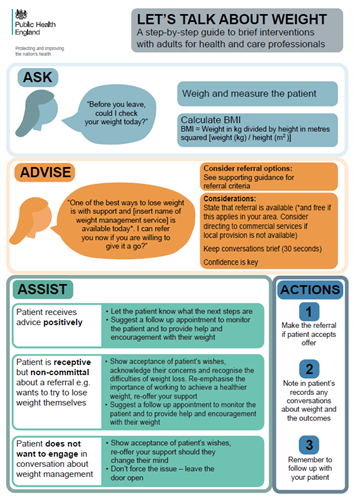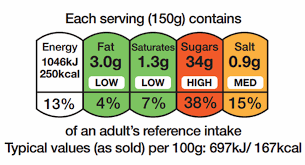Healthy Diet and Healthy Weight
Whether you're trying to lose weight, get in shape or just live a healthier life, eating well has lots of benefits. From improving your health to saving you money, there are lots of reasons to eat well.
If you eat too many foods that are high in fat and sugar, and you're not active, you're more likely to put on weight.
You can still enjoy the foods you love, by making some small changes and food swaps to help you cut back. Swapping a side of chips for a side of salad is an example that
Health Professionals can use the 'Lets talk about weight'
Practical advice and tools to support health and care professionals make brief interventions in weight management for adults
https://www.gov.uk/government/publications/adult-weight-management-a-guide-to-brief-interventions

Very Brief Intervention
Ask
What is your relationship with food like?
- Often other factors such as stress, relationship breakdowns, body dysmorphia or neurodivergent disorders lead to disordered eating patterns. It may be worth exploring the reasoning behind their eating patterns
- Find out more on the impact of neurodivergence on eating patterns: Eating Disorders and Neurodivergence (withinhealth.com)
- Recommend a GP referral for a diagnosis and in the meantime suggest Cognitive Behavioural Therapy (CBT), Dialectal Behavioural therapy (DBT), Interpersonal psychotherapy (IPT) also through GP referral or BetterHelp BetterHelp - Get Started & Sign-Up Today
How important is it for you to eat healthily?
- Empathise that this not always easy to eat the recommended 5 portions of fruit and vegetables per day but we can all cut down on fat, salt and sugar whenever we can.
- Eating healthily and the right amount can help you feel your best, stop you gaining weight and lower your risks of getting major diseases.
- When it comes to watching your weight, it's not just food you need to watch out for as some drinks can also be high in calories.
How would you most like to improve what you eat, if you could?
- If the answer indicates a desire to increase fruit and veg into the diet then you may wish to signpost them to the NHS Choices '5 a day top tips' (in ACT section)
- If the answer indicates a desire for healthy food recipes then you may wish to signpost them to the Change for Life website which has some useful resources in for healthy meals and lunchboxes. (in ACT section)
What types of drinks do you have in a typical day?
- Health Professionals can use the 'Lets talk about weight'
- Suggest healthy alternative such as flavoured water in place of juices and explain the recommended intake of sugar per day. You may inform them of the risk of cardiovascular diseases, diabetes and stroke with increased sugar intake.
https://www.gov.uk/government/publications/adult-weight-management-a-guide-to-brief-interventions
Assist
Explain the some food manufactures and supermarkets display nutritional information on packed foods and this can be useful when comparing different food products
- Front-of-pack labels, such as the label in the above image, usually give a quick guide to:
- energy
- fat content
- saturated fat content
- sugars content
- salt content

- Some front-of-pack nutrition labels use red, amber and green colour coding
- Colour-coded nutritional information, as shown in the image above, tells you at a glance if the food has high, medium or low amounts of fat, saturated fat, sugars and salt
- red means high
- amber means medium
- green means low
- In short, the more green on the label, the healthier the choice. If you buy a food that has all or mostly green on the label
Factsheet on a healthy diet from WHO
A balanced diet contains foods from all the five major food groups. The Eatwell Guide above encourages us to eat:
- At least five portions of a variety of fruit and vegetables every day
- Meals based on potatoes, bread, rice, pasta or other starchy carbohydrates; choosing wholegrain versions where possible have some dairy or dairy alternatives (such as soya drinks); choosing lower fat and lower sugar options
- Beans, pulses, fish, eggs, meat and other proteins (including two portions of fish every week, one of which should be oily)
- Unsaturated oils and spreads and eat in small amounts
- Drink 6-8 cups/glasses of fluid a day if consuming foods and drinks high in fat, salt or sugar, have these less often and in small amounts.
Would you consider swapping some high sugar drinks for low sugar alternatives?
- Did you know that swapping one sugary soft drink with water can have huge benefits to your health. One typical can of regular soft drink can have around 7-10 teaspoons of sugar which is around the 39 grams of sugar which itself exceeds the recommended maximum sugar intake for an average adult for a whole day.
- Did you know that tooth decay from high sugary food is the biggest cause of hospital admissions among young children, would you be interested in some information on sugar swaps for food and drink?
Act
Better Health - NHS (www.nhs.uk)
Self Care
- The Public Health England 'One You' Website contains a wealth of information on different food choices and healthy recipes
- Visit the healthy eating page on the 'Change for Life' website which has loads of great information about food and drink swaps for a healthier diet.
- Try the new 'Be Food Smart app'! See how much sugar, sat fat and salt is really inside your food and drink - just by scanning the barcode from your mobile phone, Android and Iphone Apps available.
- Visit the recipes page on 'Change for Life' has a extensive list of recipes for breakfast, lunch, dinner and lunchboxes!
- NHS Choices has a useful list of tips on how to add your 5 a day into your daily meals
Eating Disorders
Use this HelpFinder from Beat a national charity to find local people and organisations that support people suffering from eating disorders: Welcome to HelpFinder - HelpFinder (beateatingdisorders.org.uk)
Talk ED, a platform listed on Yippy Health, dedicated to supporting individuals affected by eating disorders. Talk ED provides essential resources, expert guidance, and a supportive community aimed at promoting recovery and well-being for those struggling with eating disorders. There is a range of services and find the help you need. Visit the Talk ED profile on Yippy Health for more information.
Local Support and Contact Details
Bath and North East Somerset
Healthy Diet and Healthy Weight
This is a Healthy Lifestyle Service programme of courses that work with parents and carers to improve the diet of children and young people up to the age of 17 years old.
Who is this service for?
Our service targets families in the areas of the highest health need who are either registered with a GP, or who live or work within Bath and North East Somerset.
Food and Health Courses for Families: https://bathneshealthandcare.nhs.uk/wellness/food-and-health-courses-for-families/
The Community Wellbeing Hub: https://communitywellbeinghub.co.uk/
Information on healthy eating: https://www.bathnes.gov.uk/services/environment/sustainability/local-food/healthy-and-sustainable-diets
Weight management services for adults: https://bathneshealthandcare.nhs.uk/wellness/slimming-on-referral/
Weight management services for children: https://bathneshealthandcare.nhs.uk/childrens/childrens-weight-management/
Support for Eating Disorder
Weight management
It's important to keep a healthy weight. Enter your weight and height into the NHS healthy weight calculator to check which range you fall into.
Healthy Us
Healthy Us – Adult Weight Management:
Healthy Us is a free 12 week adult group weight management programme open to anyone living in Wiltshire, aged 18 years or over (14+ with a parent or carer) and with a BMI (Body Mass Index) of 28 or above.
Email: health.coaches@wiltshire.gov.uk
Telephone: 0300 003 4566 - option 1
Find out more on the website: Health Coaches
Healthy Me – Children’s weight management
A free healthy lifestyle programme for 5 to 18-year-olds and their families. The sessions support the child and their family to learn about healthy eating and physical activity in a fun and interactive way.
Email: healthyme@wiltshire.gov.uk
Telephone: 0300 003 4566 - option 1
Find out more on the website: Weight management - Wiltshire Council
Local Walks
The National Trust website for Wiltshire has a variety of trails that showcase the area's stunning landscapes, historical sites, and natural wonders. Whether you're looking for a leisurely stroll or a challenging hike, there's something for everyone. Visit the National Trust's Wiltshire walking page
